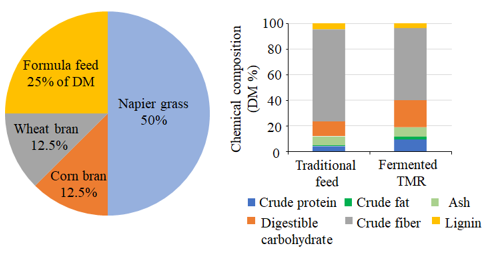Feeding of fermented TMR prepared with local feed resources improves milk production and profitability in Mozambique
Description
In Sub-Saharan Africa, feed shortages during the dry season are a major factor restricting livestock production. In Mozambique, which is located in Southern Africa, ruminants graze mainly on native grasslands and are customarily raised in combination with supplementary feeding of crop residues. However, this feeding method could not meet the nutritional requirements of dairy cows, and feeding them low-quality roughage adversely affects milk production. Therefore, locally available feed resources are expected to be used for preparing fermented total mixed ration (TMR) and improving livestock raising methods to promote the revitalization of local animal husbandry and improve the livelihoods of local people.Fermented TMR was prepared in Mozambique with locally available feed resources including grass, crop by-products, and formulated feed using the simple plastic bag storage method (Fig. 1). Ten Jersey dairy cattle aged 3 to 4 years old with an average weight of 336.6±19.8 kg were used for a livestock feeding experiment. Fermented TMR prepared with Napier grass (Pennisetum purpureum Schmach), corn bran, wheat bran, and formula feed, was found to be rich in nutrients such as crude protein and crude fat, and can meet the nutritional needs of Jersey dairy cattle (Fig. 2). After 14 days of fermentation, the pH value of the fermented TMR was as low as 3.9, the ammonia nitrogen content was less than 0.01% of fresh material (FM), butyric acid and propionic acid were not detected, while lactic acid was produced in FM 1.0%. According to the criteria for evaluation of silage, the fermented TMR showed good fermentation quality (Table 1). Compared with the traditional diet, dairy cattle fed with TMR had better palatability, and the intake, dry matter digestibility, milk production, and profitability were significantly (p<0.05) improved (Fig. 3).
As an application of this result, the available sealing materials and feed resources can be used to prepare fermented TMR in other tropical and subtropical regions during the rainy and dry seasons. By using TMR to improve the feeding method of dairy cows, milk production can be stably increased. One thing to keep in mind is that when the TMR prepared by this simple preparation method is stored for more than one month, it is necessary to pay attention to the occurrence of aerobic deterioration caused by damage to the plastic bag. In this study, only fermented TMR with high-moisture Napier grass as the main component was prepared, so it is necessary to compare and analyze the feeding effects of fermented and non-fermented TMR on dairy cows. In addition, these results are limited to the improvement of raising methods, and other factors that hinder the promotion of dairy farming, such as hygiene management, disease control, and breeding management require other improvement efforts.
Figure, table
-
Fig. 1. Preparation (left), storage (middle) and dairy cattle feeding (right) on fermented TMR
-
Fig. 2. Ingredients (left) and chemical composition (right) of fermented TMR
Digestible carbohydrate = carbohydrate – crude fiber – lignin.
-
Table 1. Fermentation quality of TMR after 14 days of ensiling
Evaluation criteria
TMR Material
Fermented TMR
pH <4.2 6.2 3.9 Lactic acid, FM % ≧1.0 ND 1 Acetic acid, FM % - ND 0.3 Propionic acid, FM % ND ND ND Butyric acid, FM % ND ND ND Ammonia=N, FM % <0.05 ND <0.01 ND: not detected, FM: fresh matter
-
Fig. 3. Performance of dairy cattle fed traditional feed and fermented TMR
*Means of five cattle differ significantly (p<0.05).
- Affiliation
-
Japan International Research Center for Agricultural Sciences Crop, Livestock and Environment Division
- Classification
-
Research
- Research project
- Program name
- Term of research
-
FY2020(FY2016~FY2020)
- Responsible researcher
-
Cai Yimin ( Crop, Livestock and Environment Division )
Du Zhumei ( Crop, Livestock and Environment Division )
Yamasaki Seishi ( Crop, Livestock and Environment Division )
Oya Tetsuji ( Crop, Livestock and Environment Division )
Nguluve Damiao ( Agricultural Research Institute of Mozambique )
Tinga Benedito ( Agricultural Research Institute of Mozambique )
Macome Felicidade ( Agricultural Research Institute of Mozambique )
- ほか
- Publication, etc.
-
Du Z et al. (2020) Animal Science Journalhttps://doi.org/10.1111/asj.13370
- Japanese PDF
-
2020_B05_A4_ja.pdf551.6 KB
2020_B05_A3_ja.pdf551.11 KB
- English PDF
-
2020_B05_A4_en.pdf642.18 KB
2020_B05_A3_en.pdf643.09 KB
- Poster PDF
-
2020_B05_poster.pdf235.85 KB
* Affiliation at the time of implementation of the study.



